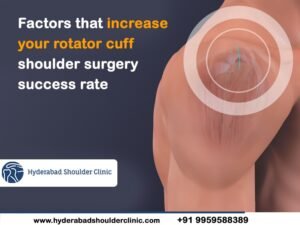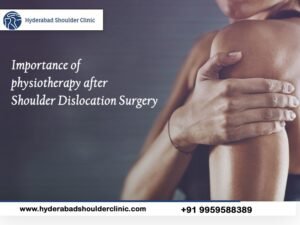Rotator cuff tears are often a result of age-related wear and tear. One can get a rotator cuff tear from a fall or sporting injury. The rotator cuff is crucial for the stability of the shoulder joint. It enables shoulder movement and empowers the shoulder and arm. A rotator cuff is a group of four muscles and related tendons. It attaches the humerus to the shoulder blade and helps to lift and rotate your arm. A lubricating sac known as a bursa exists between the rotator cuff and the bone on top of your shoulder (acromion). The bursa helps the rotator cuff tendons to glide freely when you move your arm. In case of rotator cuff tendons are damaged or injured, the bursa becomes inflamed and painful.
In such cases, rotator cuff surgery helps alleviate pain and restore shoulder movement and strength. The surgery is performed with general anaesthesia. The shoulder will become pain-free for a period afterwards.
Post Rotator Cuff Surgery Repair
The patient will leave the hospital the same day, and the shoulder should be numb and pain-free. You must be wearing a sling and start taking tablets for pain relief later that day before the shoulder block wears off. Once the anaesthesia wears off and some feeling returns in the shoulder, the pain should be manageable, and you should remain comfortable.
Your return to work depends on your job’s responsibilities. You must discuss with your surgeon a timeline to return to work. If yours is a desk job, you are more likely to return to work faster than a job requiring physical labour that involves lifting.
Post of Rotator Cuff Surgery Journey
During the surgery, the rotator cuff tendon is reattached to the bone of your humerus and is only held in place by a few sutures. But the sutures cannot support you in your everyday activities.
For 4 weeks, you have to remain in a sling but take it off to do exercises, shower, and when resting at home. Stay away from driving during these 4 weeks. After the first 4 weeks, you need to be comfortable enough and have adequate movement and some strength before returning to driving, which usually takes about 6 weeks.
Rehab is a must after rotator cuff surgery, lasting up to 4 to 6 months. Rehabilitation is vital in getting you back to your daily activities. A physical therapy program helps in regaining shoulder motion and strength.
0-4 weeks after the surgery
The result of this phase is:-
- Reduce pain
- Protect the surgical repair of the tendon
- Optimise tissue healing
- Maintain and regain range of motion
- Minimise muscle inhibition
In this rehabilitation phase, the physiotherapists will help you move your shoulder passively up to shoulder height (90 degrees) and rotate outwards to 20 degrees. They will also guide you to support your arm whilst pushing it to these limits. Only essential and gentle shoulder strengthening exercises are permitted. These gentle exercises also prevent the shoulder from becoming stiff whilst protecting the repaired tendon.
4-8 weeks after the surgery
The result of this phase is:-
- End of sling usage
- Improved functional range of movement, including total elevation
- Improved cuff and scapular range of movement
All the exercises that your physiotherapist will teach you will be focussed on improving your range of movement, introducing active activities where the muscle and tendons are activated. The rehabilitation programme also helps regain the strength and function of the tendon and muscle. A water exercise program (Hydrotherapy) is highly encouraged during this phase.
8 weeks onwards recovery – Return to work phase
By the end of this phase, the goals are:
- Have a full range of movement
- Establish neuromuscular control of the shoulder girdle
- Optimal cuff and scapular control under load and increase specific power, strength and endurance
- Return to work, sports and recreational activities. Hurray !!!
After 8 weeks of disciplined training, your tendon heals and is strong enough to allow more movement and strength exercises. In this phase, active movement is achieved, and shoulder power and strength can be attained.
Above all, you can return to physical movement at your job, sporting, and recreational activities.
4 – 6 Months after the surgery
Achieving end-range strength, power, and endurance take 4 to 6 months after surgery. This final stage of rehabilitation ensures that you don’t suffer these injuries in the future.
As it is evident that rotator cuff surgery involves a long recovery process. But your commitment to rotator cuff rehab is key to a successful outcome. Please remember that the repaired rotator cuff continues to become more robust as time progresses. Dr Chandra Sekhar, one of the best shoulder surgeons in Hyderabad and his team are there with you throughout the whole period. For any shoulder-related issues please call 99595 88389 and book your slot.





